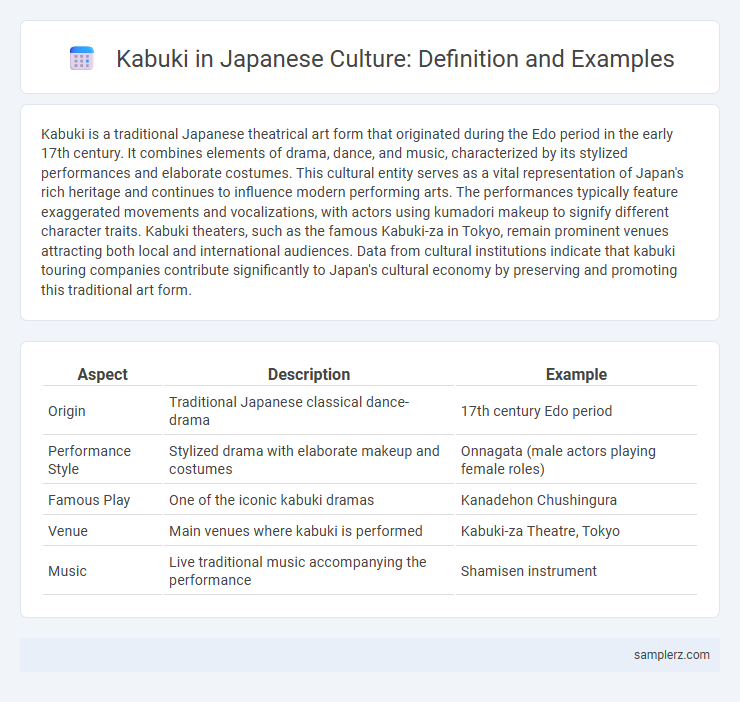Kabuki is a traditional Japanese theatrical art form that originated during the Edo period in the early 17th century. It combines elements of drama, dance, and music, characterized by its stylized performances and elaborate costumes. This cultural entity serves as a vital representation of Japan's rich heritage and continues to influence modern performing arts. The performances typically feature exaggerated movements and vocalizations, with actors using kumadori makeup to signify different character traits. Kabuki theaters, such as the famous Kabuki-za in Tokyo, remain prominent venues attracting both local and international audiences. Data from cultural institutions indicate that kabuki touring companies contribute significantly to Japan's cultural economy by preserving and promoting this traditional art form.
Table of Comparison
| Aspect | Description | Example |
|---|---|---|
| Origin | Traditional Japanese classical dance-drama | 17th century Edo period |
| Performance Style | Stylized drama with elaborate makeup and costumes | Onnagata (male actors playing female roles) |
| Famous Play | One of the iconic kabuki dramas | Kanadehon Chushingura |
| Venue | Main venues where kabuki is performed | Kabuki-za Theatre, Tokyo |
| Music | Live traditional music accompanying the performance | Shamisen instrument |
Introduction to Kabuki: A Timeless Japanese Art
Kabuki is a traditional Japanese performing art that combines drama, dance, and music, originating in the early 17th century Edo period. Renowned for its stylized performances, elaborate costumes, and dynamic makeup, Kabuki captivates audiences with its rich narratives rooted in historical events and folk tales. This timeless theatrical form remains a vital cultural heritage, showcasing Japan's artistic innovation and storytelling tradition.
Origins and Evolution of Kabuki Theatre
Kabuki theatre originated in the early 17th century during Japan's Edo period, founded by Izumo no Okuni, a shrine maiden who introduced a form of dance drama featuring stylized movements and elaborate costumes. Initially performed by women, kabuki evolved as male actors took over, developing defined roles such as onnagata, specialists in female parts, which significantly shaped its dramatic and visual style. Over centuries, kabuki integrated various influences including Noh and Bunraku, constantly adapting while preserving traditional storytelling centered on historical events, moral conflicts, and the lives of the common people.
Iconic Kabuki Plays and Their Stories
Iconic kabuki plays such as "Kanadehon Chushingura" dramatize the historical tale of the 47 ronin's loyalty and revenge, highlighting themes of honor and sacrifice. "Sugawara Denju Tenarai Kagami" portrays the life of scholar Sugawara no Michizane, emphasizing loyalty and political intrigue. These plays utilize vivid makeup, intricate costumes, and stylized movements to convey complex emotions and traditional Japanese values.
Signature Costumes and Makeup in Kabuki
Kabuki in Japan is renowned for its elaborate signature costumes that feature vibrant colors, intricate patterns, and symbolic designs reflecting the character's role and status. The makeup, known as kumadori, uses bold red, blue, and black lines to emphasize facial expressions and convey emotions such as strength, villainy, or passion. These distinctive visual elements are integral to Kabuki's dramatic storytelling and cultural heritage.
Famous Kabuki Actors and Lineages
Famous kabuki actors such as Ichikawa Danjuro and Nakamura Kanzaburo represent centuries-old lineages that have shaped the art form, preserving traditional performance styles while innovating within the genre. The Ichikawa family, renowned for their aragoto acting style, passes down not only stage names but also secret techniques and repertoire across generations. These hereditary lineages maintain kabuki's cultural legacy, ensuring continuity and distinctiveness in Japan's theatrical heritage.
Kabuki Theatre Architecture and Stages
Kabuki theatre architecture in Japan features distinctive, intricate designs that enhance acoustic quality and audience engagement, with the Hanamichi walkway stage extending into the crowd for dynamic actor entrances. Traditional Kabuki stages incorporate trapdoors and revolving platforms, allowing seamless scene changes and dramatic effects pivotal to storytelling. The use of vibrant colors and ornamental details in theatre buildings reflects Edo-period aesthetics, reinforcing Kabuki's cultural heritage and immersive theatrical experience.
Traditional Music and Instruments in Kabuki
Kabuki theater in Japan showcases traditional music played with unique instruments such as the shamisen, a three-stringed lute essential for creating rhythm and mood. The fue, a bamboo flute, and taiko drums provide dynamic accompaniment, enhancing dramatic scenes and emotional expression. These instruments collectively preserve centuries-old musical techniques integral to the Kabuki cultural heritage.
Kabuki's Role in Modern Japanese Culture
Kabuki remains a vital part of modern Japanese culture, blending traditional theatrical techniques with contemporary themes to engage diverse audiences. This classical art form showcases elaborate costumes, dramatic makeup, and stylized performances that preserve historical narratives while reflecting current social issues. Kabuki theaters in cities like Tokyo and Kyoto serve as cultural hubs, attracting both local enthusiasts and international tourists.
Cultural Symbolism and Themes in Kabuki
Kabuki, a traditional Japanese theatrical form originating in the Edo period, embodies rich cultural symbolism through its elaborate costumes, dramatic makeup, and stylized movements that convey complex themes of honor, loyalty, and social conflict. The use of color-coded makeup, such as red for heroism and blue for villainy, enhances the narrative by visually distinguishing characters' moral alignments. Central themes frequently explore the tension between individual desires and societal obligations, reflecting historical values and the dynamic nature of Japanese culture.
Experiencing Kabuki: How to Watch a Performance
Watching a kabuki performance in Japan involves understanding its unique blend of stylized drama, elaborate costumes, and dramatic makeup. To fully experience kabuki, visitors should arrive early to explore the theater, purchase a "matinee ticket" called "Ichimai-ken" for affordable access, and refer to English subtitles available at major venues like the Kabuki-za Theatre in Tokyo. Engaging with guide pamphlets and attending shows during special events such as the New Year or seasonal performances enhances cultural appreciation and immersion.

example of kabuki in Japan Infographic
 samplerz.com
samplerz.com